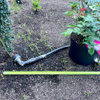flowering shrub not mind wet feet or clay soil?
chueh
10 years ago
Related Stories

GARDENING GUIDESGardening Solutions for Heavy Clay Soils
What’s a gardener to do with soil that’s easily compacted and has poor drainage? Find out here
Full Story
GARDENING GUIDESHow to Stop Worrying and Start Loving Clay Soil
Clay has many more benefits than you might imagine
Full Story
GARDENING GUIDES10 Solutions for Soggy Soil
If a too-wet garden is raining on your parade, try these water-loving plants and other ideas for handling all of that H2O
Full Story
GARDENING GUIDES9 Clay-Busting Native Flowers for Summer Sun
These plants survive and even thrive in tough clay soil east of the Rocky Mountains
Full Story
LANDSCAPE DESIGNFlood-Tolerant Native Trees for Soggy Soil
Swampy sites, floodplains, even standing water ... if you've got a soggy landscape, these trees are for you
Full Story
GARDENING GUIDESHow to Pick a Mulch — and Why Your Soil Wants It
There's more to topdressing than shredded wood. Learn about mulch types, costs and design considerations here
Full Story
GARDENING GUIDES8 Native Shrubs for Year-Round Bird Feeding
It’s not just about berries. These plants provide insects for birds and seasonal interest for gardeners
Full Story
GARDENING GUIDES5 Prairie Wildflowers That Can Heal Your Soil
Get free, organic soil fertilizer with nitrogen-pumping plants that draw pollinators too
Full Story
GARDENING GUIDESHave Acidic Soil in Your Yard? Learn to Love Gardening Anyway
Look to acid-loving plants, like conifers and rhododendrons, to help your low-pH garden thrive
Full Story
FARM YOUR YARDHow to Get Good Soil for Your Edible Garden
The nutrients in your soil feed the plants that feed you. Here are tips on getting it right — just in time for planting season
Full StoryMore Discussions







NHBabs z4b-5a NH
chuehOriginal Author
Related Professionals
Windham Landscape Architects & Landscape Designers · Horsham Landscape Architects & Landscape Designers · Port Royal Landscape Architects & Landscape Designers · Bainbridge Island Landscape Contractors · Duarte Landscape Contractors · Round Lake Landscape Contractors · Vancouver Landscape Contractors · Coral Gables Window Contractors · Mamaroneck Window Contractors · White Center Window Contractors · Brea Driveway Installation & Maintenance · Clermont Driveway Installation & Maintenance · Boston Decks, Patios & Outdoor Enclosures · Clute Decks, Patios & Outdoor Enclosures · Portland Decks, Patios & Outdoor EnclosuresEmbothrium
chuehOriginal Author